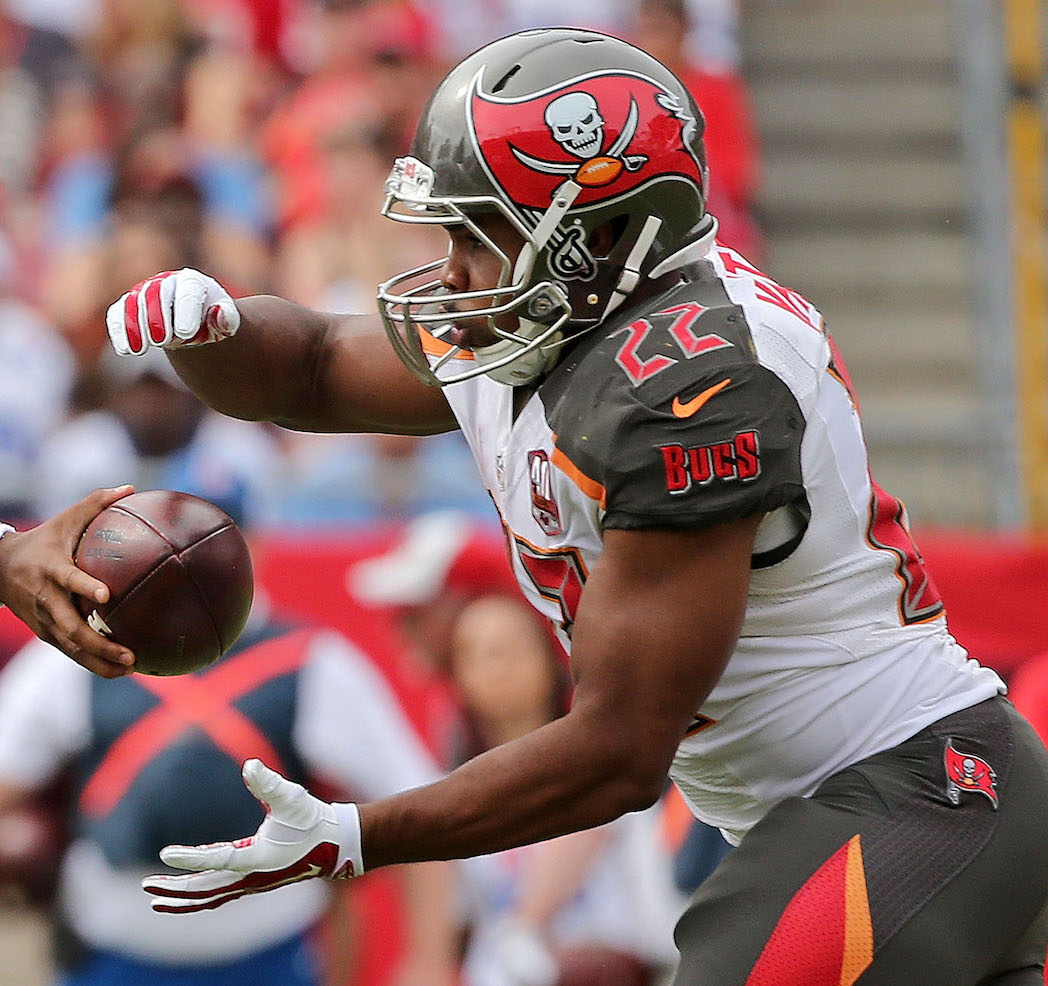(“Today's Crazy Fantasy Stat” is an occasional offseason offering from PFF that highlights something that catches our eye and aids in our preparation for the 2017 fantasy season.)
Without actually checking this statement in depth, I would wager that there haven’t been many weirder careers in recent memory than that of Tampa Bay running back Doug Martin. He’s finished as fantasy’s No. 3 back twice (2012 and 2015), and worse than 45th in his other three seasons. Even extrapolating out his per-game samples to a full 16-game season, his “off” seasons would have ranked 21st (2016), 34th (2014), and 19th (2013), compared to his two third-place years. By PFF grades, he’s finished at 80.0 or above twice, and 67.0 or below three times.
Obviously, his future is murky right now. Martin was hit with a four-game suspension late last season, getting one game out of the way before the season ended. So he’s got three games to miss in 2017. There’s still a chance the Buccaneers could just move on from him, especially if they get in on Adrian Peterson’s free agency or get one of the prime running backs in this year’s draft. But whether Martin is in Tampa Bay or elsewhere when his suspension runs out, the question at this point has to be what version of the running back is likely to show up — the first-rounder of 2012 and 2015, or the waiver fodder of his other seasons?
(Subscribe to all our fantasy content, or get everything PFF offers with an All-Access subscription.)
While it’s obviously no guarantee either way — we’d have guessed 2013 Martin would look like 2012, and 2016 Martin would resemble 2015, for example — let’s say that the prognosis isn’t rosy. For one thing, Martin last year had a breakaway percentage (percentage of yards gained on runs of 15 yards or more) of 7.8, lowest in the league for a running back with 100-plus carries, and 14th-lowest in the last decade. The list of players who have fallen under the 10-percent threshold in the last decade is not an illustrious one, with the biggest name (other than Adrian Peterson, because it isn’t that Adrian Peterson) probably being Martin himself. Or Trent Richardson.
There are a few things to check when noticing something like that:
- Can a running back succeed with an awful breakaway percentage?
Yes, but it isn’t easy. The 27 running backs with a sub-10 percent breakaway percentage in the last decade have averaged a No. 37 finish in fantasy scoring. But four (2014 Matt Asiata, 2013 Danny Woodhead, 2012 Mikel Leshoure, 2009 Joseph Addai) have finished in the top 20, and one (Addai) has been a top-10 back. Basically, a high breakaway percentage indicates “quality,” and without it you need so much more “quantity.” - Can a running back rebound to a big fantasy season the next year?
Again, yes, but it also isn’t common. Of the 25 backs before 2016 who qualified, six didn’t play at all the next year. Of the other 19, five finished in the top 20, including that 2009 Addai season — he had also been under 10 percent in 2008. But several others struggled to find any sort of relevance — only two backs finished between 20th and 40th in fantasy scoring, indicating it was a real boom-or-bust group. - Is breakaway percentage predictive from one year to the next?
Not really. In the last 10 years, 256 running backs have put up 100-plus carries in back-to-back years. Charting their first- and second-year breakaway percentages against one another yields an R-squared value of 0.048, basically nothing. In 2011, Fred Jackson’s breakaway percentage was 45.6 on 170 carries; it fell to 3.4 percent on 115 carries the next year. In 2009, Darren McFadden had an 11.8 on 104 carries; that rose to 45.7 on 222 carries the next year. You’d rather have a high breakaway percentage than a low one, but ultimately, it’s not that predictive year-over-year. - So, could Martin be OK?
Sure he could be. At the same time, everything looked worse for Martin in 2016 than it did in 2015. Martin forced 67 tackles in 2015 (on 321 touches), most among all running backs. Last season, that fell to 22 on 144 carries. His elusive rating fell from 65.7 to 34.6. His yards-after-contact average was above 3.0 in his “good” years, 2.5 or under in his “bad” ones.
Martin is about as much of an enigma as any player in football. A Pro Bowl season in his 13 games in 2017 would be totally believable, as would a release from Tampa Bay and difficulty catching on with a new team. As it stands, with so much up in the air, there’s no way to confidently say where Martin should go in drafts. But anyone drafting him as a starter, a flex, or even the top backup will be doing so with a whole host of grains of salt. There’s no player with a wider gap between ceiling and floor in the entire league.




 © 2025 PFF - all rights reserved.
© 2025 PFF - all rights reserved.